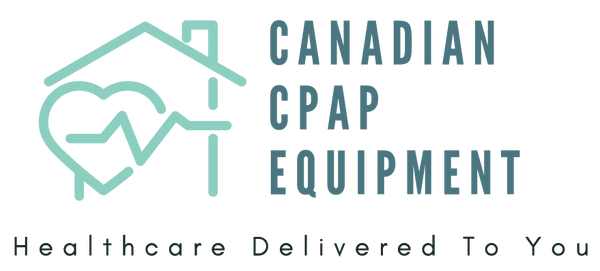If you have recently been diagnosed with sleep apnea, particularly Obstructive Sleep Apnea (OSA), one of the most common and effective treatment recommendations you will hear is Continuous Positive Airway Pressure, or CPAP therapy. While the idea of sleeping with a machine might seem daunting at first, CPAP has revolutionized sleep apnea treatment, offering a non-invasive way to ensure open airways and restorative sleep. If you haven’t yet been officially diagnosed, consider taking a home sleep apnea test before beginning treatment. This guide will explain what CPAP therapy is, how it works, and what you can expect as you take your first steps towards better sleep.
What is CPAP Therapy?
CPAP therapy involves using a small machine that delivers a continuous stream of pressurized air through a hose to a mask worn over your nose, or nose and mouth, while you sleep. The constant air pressure acts as a pneumatic splint, gently holding your airway open and preventing it from collapsing. This eliminates the pauses in breathing (apneas) and shallow breathing (hypopneas) that characterize sleep apnea, allowing you to breathe freely and continuously throughout the night.
How Does CPAP Work?
Imagine your airway as a soft tube. During sleep, especially with OSA, the muscles in your throat relax, and gravity can cause the soft tissues to collapse, blocking this tube. The CPAP machine works by:
-
Drawing in Room Air: The machine takes in air from the room.
-
Filtering and Humidifying (Optional): The air is filtered, and often, a heated humidifier adds moisture to prevent dryness and irritation in your airways.
-
Pressurizing the Air: The machine then pressurizes this air to a specific level, determined by your sleep-trained respirologist.
-
Delivering to Your Airway: This pressurized air travels through a hose to your mask, creating a gentle cushion of air that keeps your throat from collapsing. This ensures a continuous and unobstructed flow of oxygen to your lungs.
The Benefits of CPAP Therapy
The impact of consistent CPAP therapy extends far beyond just stopping snoring. It can dramatically improve your health and quality of life by:
-
Eliminating Apneas and Hypopneas: This is the primary benefit, ensuring continuous breathing and oxygen supply.
-
Restoring Restorative Sleep: By preventing breathing interruptions, CPAP allows you to achieve deeper, more restorative sleep cycles.
-
Reducing Daytime Sleepiness: You'll wake up feeling more refreshed and energized, leading to improved concentration, mood, and productivity.
-
Lowering Health Risks: Consistent CPAP use can significantly reduce the risk of serious health complications associated with untreated sleep apnea, such as high blood pressure, heart disease, stroke, and Type 2 Diabetes.
- Improving Overall Well-being: Many users report a significant improvement in their overall mood, energy levels, and general quality of life.
What to Expect When Starting CPAP Therapy
Starting CPAP therapy is a journey, and like any new routine, it may require an adjustment period. Here's what you can typically expect:
1. Choosing Your Equipment
Your respirologist will provide a prescription outlining the necessary pressure settings. You'll then work with a CPAP provider to select the right machine, mask, and accessories. There are various types of masks (nasal pillows, nasal masks, full-face masks) to suit different preferences and sleeping styles. A proper mask fit is crucial for comfort and effectiveness.
2. The Adjustment Period
It's normal to feel a bit awkward or even claustrophobic with the mask at first. Patience and persistence are key. Most people adjust within a few days to a few weeks. Here are some tips:
-
Start Gradually: Begin by wearing the mask for short periods during the day while awake, then during naps, and gradually extend to full nights.
-
Focus on Comfort: Ensure your mask fits well without being too tight. Leaks can reduce effectiveness and cause discomfort. Your provider can help with adjustments or trying different mask types.
-
Utilize Comfort Features: Modern CPAP machines come with features designed to enhance comfort:
-
Ramp: Gradually increases pressure to your prescribed level, making it easier to fall asleep.
-
Humidifier: Adds moisture to the air, preventing dryness in your nose, mouth, and throat.
-
Heated Tubing: Prevents condensation in the hose and maintains air temperature for comfort.
-
Troubleshoot Issues: Don't hesitate to contact your CPAP provider if you experience persistent issues like mask leaks, dry mouth, or discomfort. They are there to help you optimize your therapy.
3. Ongoing Monitoring
Many modern CPAP machines record usage data, which can be reviewed by your healthcare team. This allows them to monitor your progress, ensure the therapy is effective, and make any necessary adjustments to your pressure settings.
Conclusion
CPAP therapy is a highly effective and life-changing treatment for sleep apnea. While it requires an initial adjustment, the long-term benefits to your health, energy, and overall well-being are immense. By embracing CPAP, you're taking a proactive step towards healthier, more restorative sleep and a significantly improved quality of life.
Next Steps: Finding the right mask is crucial for comfortable and effective CPAP therapy. In our next post, we'll provide a comprehensive guide to choosing the right CPAP mask for your needs.

